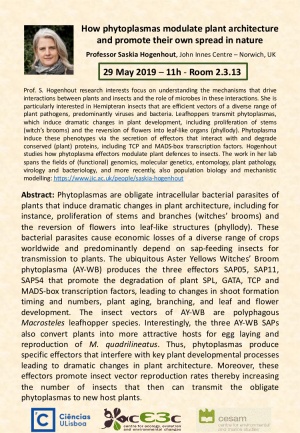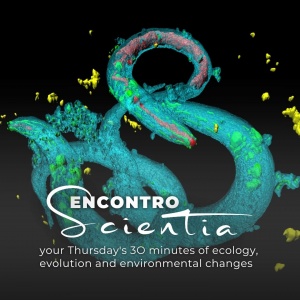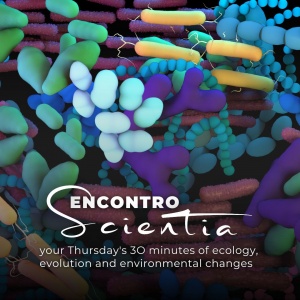How phytoplasmas modulate plant architecture and promote their own spread in nature
Saskia Hogenhout
John Innes Centre – Norwich, UK
Phytoplasmas are obligate intracellular bacterial parasites of plants that induce dramatic changes in plant architecture, including for instance, proliferation of stems and branches (witches’ brooms) and the reversion of flowers into leaf-like structures (phyllody). These bacterial parasites cause economic losses of a diverse range of crops worldwide and predominantly depend on sap-feeding insects for transmission to plants. The ubiquitous Aster Yellows Witches’ Broom phytoplasma (AY-WB) produces the three effectors SAP05, SAP11, SAP54 that promote the degradation of plant SPL, GATA, TCP and MADS-box transcription factors, leading to changes in shoot formation timing and numbers, plant aging, branching, and leaf and flower development. The insect vectors of AY-WB are polyphagous Macrosteles leafhopper species. Interestingly, the three AY-WB SAPs also convert plants into more attractive hosts for egg laying and reproduction of M. quadrilineatus. Thus, phytoplasmas produce specific effectors that interfere with key plant developmental processes leading to dramatic changes in plant architecture. Moreover, these effectors promote insect vector reproduction rates thereby increasing the number of insects that then can transmit the obligate phytoplasmas to new host plants.
Wednesday, May 29, 2019
FCUL (Building C2), 11h00, room 2.3.13
Short biography of Saskia Hogenhout:
 Prof. S. Hogenhout research interests focus on understanding the mechanisms that drive interactions between plants and insects and the role of microbes in these interactions. She is particularly interested in Hemipteran insects that are efficient vectors of a diverse range of plant pathogens, predominantly viruses and bacteria. Leafhoppers transmit phytoplasmas, which induce dramatic changes in plant development, including proliferation of stems (witch’s brooms) and the reversion of flowers into leaf-like organs (phyllody). Phytoplasma induce these phenotypes via the secretion of effectors that interact with and degrade conserved (plant) proteins, including TCP and MADS-box transcription factors. Hogenhout studies how phytoplasma effectors modulate plant defences to insects. The work in her lab spans the fields of (functional) genomics, molecular genetics, entomology, plant pathology, virology and bacteriology, and more recently, also population biology and mechanistic modelling: https://www.jic.ac.uk/people/saskia-hogenhout
Prof. S. Hogenhout research interests focus on understanding the mechanisms that drive interactions between plants and insects and the role of microbes in these interactions. She is particularly interested in Hemipteran insects that are efficient vectors of a diverse range of plant pathogens, predominantly viruses and bacteria. Leafhoppers transmit phytoplasmas, which induce dramatic changes in plant development, including proliferation of stems (witch’s brooms) and the reversion of flowers into leaf-like organs (phyllody). Phytoplasma induce these phenotypes via the secretion of effectors that interact with and degrade conserved (plant) proteins, including TCP and MADS-box transcription factors. Hogenhout studies how phytoplasma effectors modulate plant defences to insects. The work in her lab spans the fields of (functional) genomics, molecular genetics, entomology, plant pathology, virology and bacteriology, and more recently, also population biology and mechanistic modelling: https://www.jic.ac.uk/people/saskia-hogenhout







